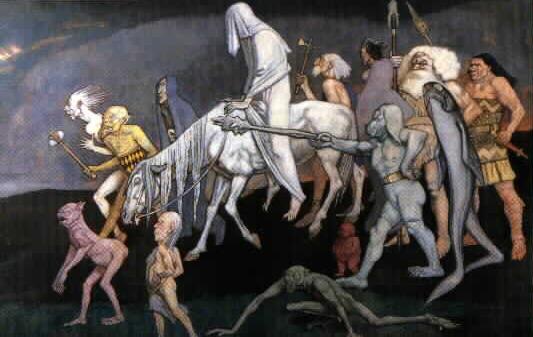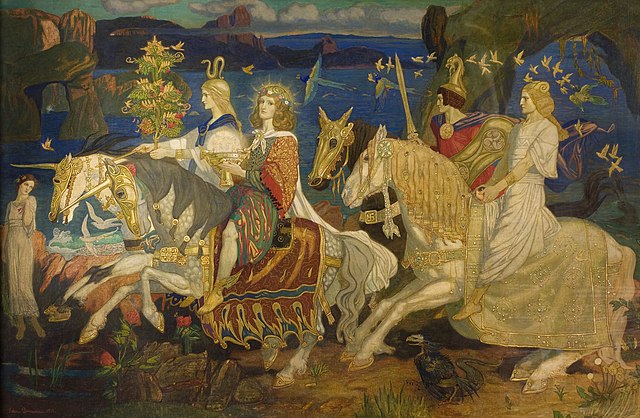Fomorians: the Mysterious Giants of Irish Mythology
Irish mythology is filled with epic tales of gods, heroes, and otherworldly creatures, each with a fascinating story. Among these legendary figures, the Fomorians stand out as some of the most mysterious and fearsome.
Known as the ancient enemies of the Tuatha Dé Danann, the Fomorians represent chaos, darkness, and destruction, constantly clashing with the forces of order and light.
The Fomorians weren’t just enemies—they were monstrous giants, often deformed and wielding terrifying power. Their battles against the Tuatha, especially in the famous Second Battle of Mag Tuired, are some of the most critical stories in Irish myth.
But who were these strange beings? Where did they come from? Their origins are as murky as the sea they were often associated with, adding to the mystery surrounding them.
Join us as we dive into the world of the Fomorians and uncover the myths behind these ancient giants of Ireland!
Table of Contents
If you are interested in learning more about Irish mythology, please read my other articles, which provide detailed information about our rich Irish heritage.
- Irish Myths and Legends
- The Legend of Tuatha Dé Danann
- List of Celtic Gods
- Lore of the Banshee
- The Tale of the Irish Leprechaun
Origins and Nature of the Fomorians

The origins of the Fomorians are shrouded in mystery, and even Irish mythology doesn’t provide a clear answer. Some believe they may represent an ancient pre-Celtic race, perhaps the first inhabitants of Ireland before other tribes arrived.
Others see them as supernatural beings closely tied to the wild forces of nature. There’s also a strong connection between the Fomorians and the sea, leading some to suggest they were sea deities or spirits of the ocean. Another suggestion is that they were sea pirates travelling to Ireland for plunder.
Physically, the Fomorians are often described as monstrous, deformed giants. Their appearance was far from human—some had one eye, arm, and leg, while others were even more grotesque.
Despite their strange forms, the Fomorians possessed incredible strength and supernatural powers, making them formidable opponents in battle.
Beyond their frightening appearance, the Fomorians were deeply connected to the forces of chaos, darkness, and the untamed natural world.
They represented everything unpredictable and destructive, contrasting the order and civilisation the Tuatha Dé Danann sought to create. In many ways, the Fomorians symbolised nature’s wild, uncontrollable elements—stormy seas, violent weather, and the darkness that can’t be easily tamed.
This connection to chaos made the Fomorians powerful but also dangerous. They were seen as beings that had to be fought and overcome to bring balance and peace to the land.
The Role of the Fomorians in Irish Mythology
In Irish mythology, the Fomorians were more than monsters—they were tyrants who often demanded control over Ireland and its people. Before the arrival of the Tuatha Dé Danann, the Fomorians held power over the Fir Bolg, an earlier group inhabiting Ireland.
The Fomorians forced the Fir Bolg to pay heavy crops, cattle, and wealth tributes, showing their dominance over the land.
However, their most significant opposition came from the Tuatha Dé Danann. When the Tuatha arrived in Ireland, they aimed to bring order, knowledge, and prosperity to the land, which directly clashed with the Fomorians’ chaotic nature.
This opposition set the stage for a series of epic battles between the two forces, with the Fomorians representing destruction and chaos and the Tuatha symbolising civilisation and harmony.
One of the most famous myths involving the Fomorians is the Second Battle of Mag Tuired. In this battle, the Tuatha Dé Danann fought to free themselves from the oppressive rule of the Fomorians.
At the centre of this conflict was Balor of the Evil Eye, the most powerful and feared of the Fomorian leaders. Balor had a giant, poisonous eye that could kill anyone with just one glance. He used his terrifying power to control the Tuatha and the land.
Balor of the Evil Eye
Balor of the Evil Eye is one of the most terrifying figures in Irish mythology. As the leader of the Fomorians, Balor was a giant with a monstrous appearance.
His most fearsome feature was his “evil eye,” which stories say rested on his forehead, while other accounts claim he may have had two or three eyes. This eye wasn’t just unusual—it had deadly power. With just one look, Balor could kill entire armies, scorch the earth, and bring death to anyone who crossed his path.
The power of Balor’s eye came from a strange origin. According to legend, his eye gained its lethal ability after being exposed to poisonous fumes. As a child, while walking past a room where Druids worked making magic potions, Balor spied in through a window to see what the Druids were doing.
The room was filled with toxic vapour, and as he peered through the window, this vapour poisoned his eye, creating his famed “evil eye”. Some stories tell that his eye was so dangerous it remained closed at all times until his soldiers would use ropes or chains and levers to lift his eyelid when he wanted to use it in battle.
Balor’s reign of terror, however, was haunted by a prophecy. It was foretold that Balor would be killed by his own grandson. Fearing this fate, Balor took extreme measures to prevent it. He locked away his daughter, Ethniu, in a tower to keep her from ever having children.
Despite his efforts, the prophecy could not be avoided. Ethniu eventually gave birth to a son, Lugh, who would grow up to be one of the most famous heroes of the Tuatha Dé Danann.
During the Second Battle of Mag Tuired, Lugh confronted his grandfather, Balor, on the battlefield. In a dramatic turn of events, Lugh used a slingshot or a magic spear to pierce Balor’s deadly eye, killing him and fulfilling the prophecy. Balor’s death marked the end of the Fomorians’ dominance over Ireland and signalled the victory of the Tuatha Dé Danann.
Lugh, often celebrated for his many talents and heroic deeds, became a key figure in Irish mythology. He was known for bringing balance and order to a land once dominated by the chaos and destruction of the Fomorians.
The defeat of Balor remains one of the most significant moments in these ancient stories, symbolising the victory of light over darkness.
Legacy of the Fomorians

Even after their defeat in Irish mythology, the Fomorians left a lasting impression on Irish folklore and storytelling. These monstrous beings became symbols of the wild, untamed forces of nature that were feared but also respected. Their stories continued to be told through generations, keeping their memory alive in Irish culture.
In later folklore, the Fomorians may have influenced tales of giants and sea spirits. Their connection to the sea and their immense size align with stories of enormous, powerful beings who could shape the natural world.
Some legends even describe Fomorians as sea monsters or spirits that control storms and turbulent waters, reflecting their deep connection to chaos and destruction.
More than villains, the Fomorians represented the wild forces of the earth that couldn’t easily be controlled. They personified chaos—storms, darkness, and the unpredictable side of nature. In mythology, they opposed the Tuatha Dé Danann, who sought to bring order and civilisation to Ireland.
Though they were ultimately defeated, the Fomorians remain a reminder that chaos and destruction are always lurking just beneath the surface of the natural world.
Their legacy symbolises power and awe, symbolising the untamable and unpredictable forces humans have long sought to understand and conquer.
Further Reading
Here are three examples of further reading to explore more about the Fomorians and Irish mythology:
“The Mythology of the British Isles” by Geoffrey Ashe
This book provides an in-depth look at the myths of Ireland, Wales, and Scotland, including detailed sections on the Fomorians and their role in Irish legends. It offers a broad overview of the mythological cycles, including the stories of the Tuatha Dé Danann and their conflicts with the Fomorians.
“Lady Gregory’s Complete Irish Mythology” by Lady Gregory
Lady Gregory’s retelling of Irish myths is a classic work, offering easy-to-read versions of many vital Irish legends. It includes the stories of the Fomorians and their battles with the Tuatha Dé Danann, making it an excellent introduction for those new to Irish mythology.
“Gods and Fighting Men” by Lady Gregory
This collection focuses on the Tuatha Dé Danann and the Fenian Cycle, emphasising the mythological battles and struggles, including those with the Fomorians. It’s an essential text for understanding the role of these ancient beings in Ireland’s mythic history.
